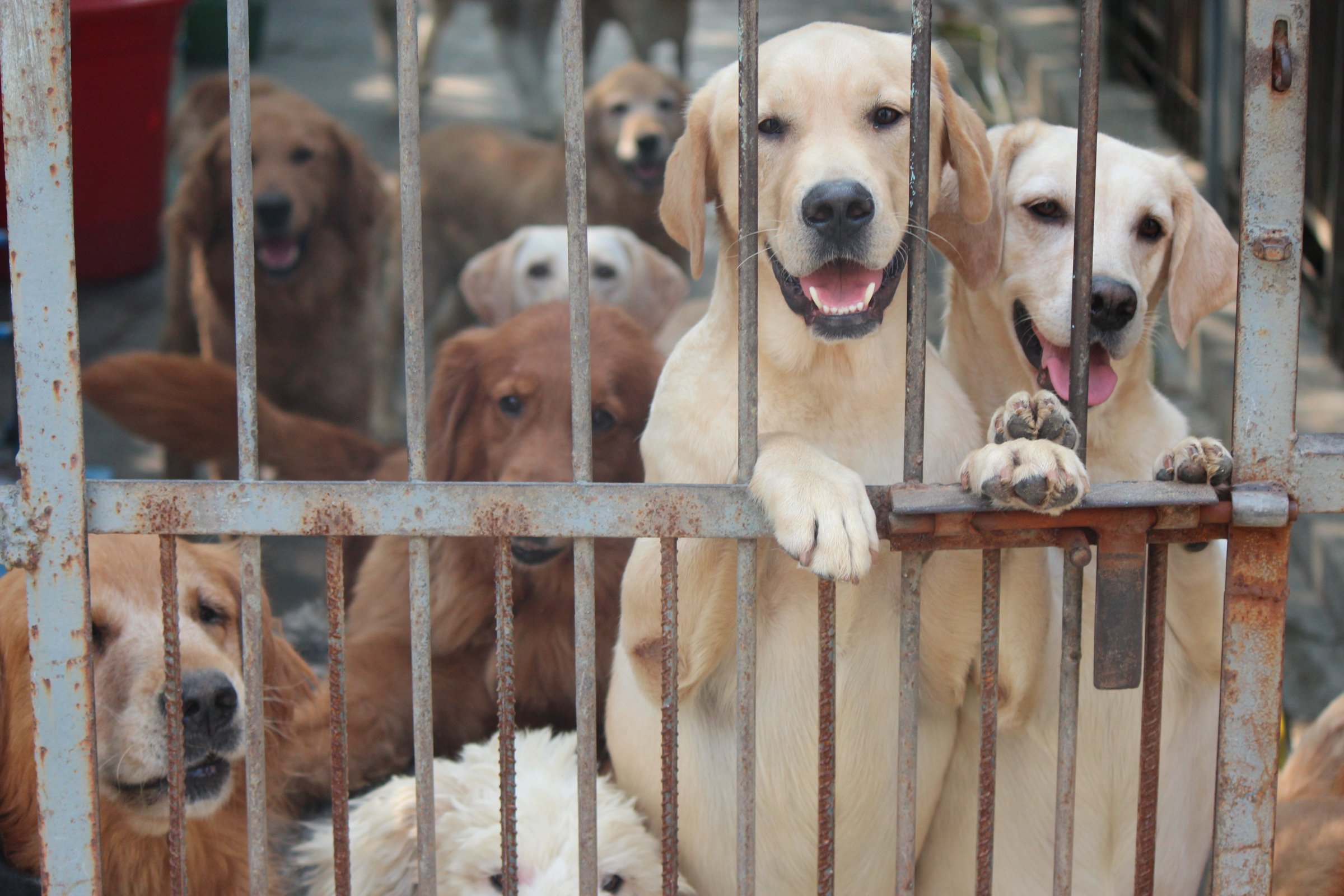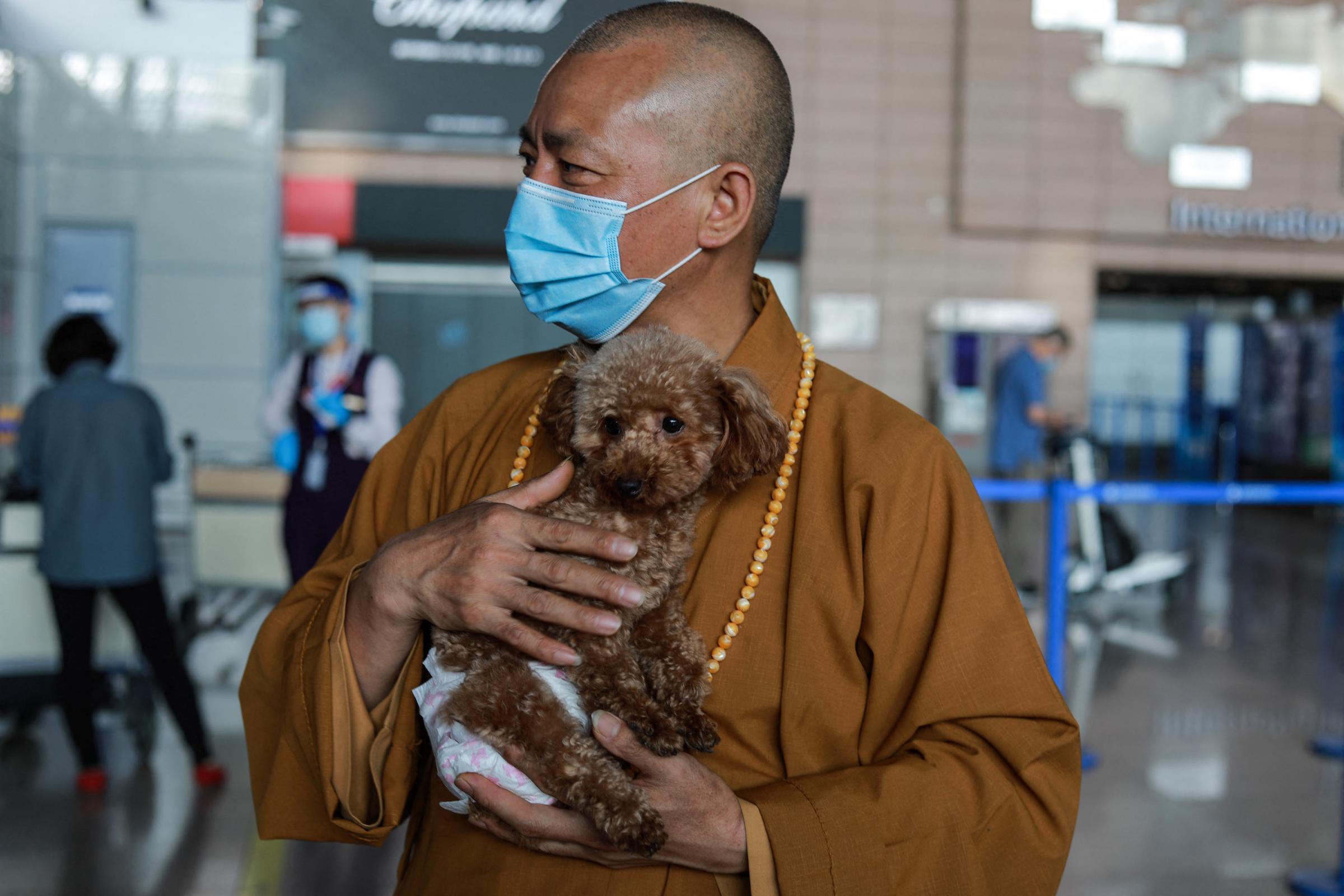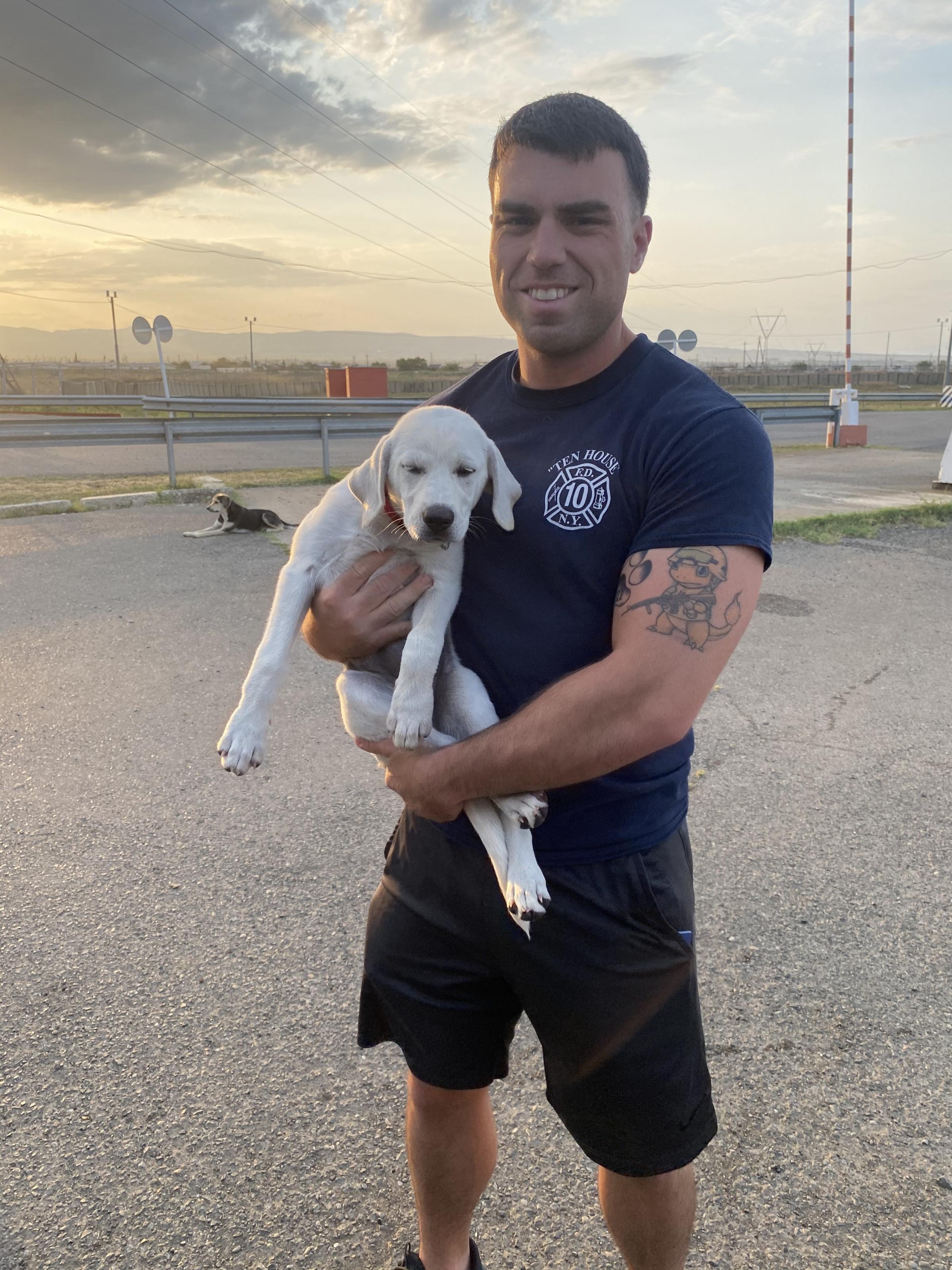
Marine Sgt. John Weldon was deployed in Syria when a dying, days-old puppy appeared at his military base in the middle of May.
To save the newborn, which was barely bigger than the hand of the local who dropped it off, the infantryman scoured the Internet for a recipe for puppy formula that he could make with limited ingredients. He nursed the pup every two to three hours with a mixture of condensed milk, egg yolk, water and yogurt, using a medical breathing tube and a syringe.
Weldon watched as the puppy he named Sully opened his eyes for the first time, as his baby teeth grew in, and as his puppy nose turn from speckled-pink to black. The two had bonded by the time the U.S. announced that, starting in July, dogs from 112 countries, including Syria, would be banned from entering the U.S. due to rabies concerns for at least a year.
Then, Weldon left Syria earlier than expected in August to help U.S. troops withdraw from Afghanistan, disrupting any chance of arranging to bring Sully home with him. “My hands were tied,” says Weldon, 30, who’s now back in California, still waiting to be reunited with his dog.
Like so many of life’s disruptions in the past 20 months, the pandemic is at the center of the predicament facing Weldon and countless other humans and animals. In 2020, as the U.S. reported shelter shortages amid surges in U.S. pet adoptions, sellers overseas capitalized on the demand, sending over hundreds of puppies with falsified vaccination records, according to the U.S. Centers for Disease Control and Prevention (CDC), which implemented the new restrictions.

The nation’s first widespread travel ban against dogs is meant to prevent people and pets from exposure to the fatal canine rabies variant, for which there is no cure, federal health officials say. But it has stranded tens of thousands of dogs, including some who’ve bonded with service members abroad, as well as others taken in by rescue groups.
About 60,000 to 100,000 dogs are imported into the U.S. each year from high-risk rabies nations, the CDC says. The crackdown comes as major airlines are canceling thousands of flights and no longer transporting dogs in cargo holds due in part to pandemic-related issues such as staffing, making it even more costly and challenging to fly with pets domestically and internationally.
Despite drastically reduced flights into the U.S. in 2020 due to COVID-19—and the reduction in animals being transported on flights—the CDC turned away nearly 460 dogs in 2020 compared to about 300 in 2019. The vast majority came from countries deemed high-risk for dog rabies, including Russia, Ukraine and Colombia.
Read more: Dog Thieves Are Capitalizing on the Demand for Pandemic Pets
That’s a bigger deal than most people might think. Globally, dog rabies kills about one person every nine minutes, and nearly half are children under 15, according to Dr. Emily Pieracci, a veterinary epidemiologist with the CDC who specializes in rabies. Spread by bites or scratches from infected hosts, dog rabies accounts for 98% of rabies-related deaths in humans worldwide, Pieracci says. It’s less feared in the U.S., where it’s been eliminated since 2007, but it was not an easy feat to get rid of the disease. And just one infected dog could undo decades of progress while creating a cascade of new public health risks, veterinary experts say.
“The canine strain would change things completely,” says Dr. José Arce, president of the American Veterinary Medical Association. While bat rabies is contained in certain U.S. wildlife reservoirs, dog rabies would be more expansive and threatening to humans. Because we live with and love dogs, an infection could likely spread rapidly from home to home in urban areas, affecting any unvaccinated warm-blooded mammal, including people and cats. “It could be a domino effect,” Arce says, “and it could just go wild.”

Despite popular Hollywood depictions of beloved pets turning into killer canines when rabid, the more common symptom of dog rabies is not extreme aggression but hyper-friendliness or lethargy, making the disease more difficult to detect. Most rabid dogs become subdued, and for many, the only symptom is that their bark sounds different. “People assume that a rabid dog is Cujo,” Pieracci says, referring to the novel and film about a killer Saint Bernard. “That is not the case.” Most animals develop symptoms within 30 days, but some don’t show signs for three months to a year, adding to the challenge, Pieracci says.
After a single rabid coyote entered Texas from Mexico in 1988, researchers say it infected hundreds of U.S. wild and domestic animals and led to two human deaths. By 1994, after the disease had spread about 160 miles north, the number of confirmed animal cases had grown from 17 to more than 530. All of them died, as did a 14-year-old boy and a 55-year-old woman. It cost millions of dollars over two decades to control the outbreak.
Read more: Some Workers Are Choosing Their Pets Over Their Jobs as Offices Reopen
Today, at least 42 states mandate rabies vaccines for pet dogs, and 38 states require cats to be vaccinated, according to Pieracci, but anti-vax sentiments permeated the pet world long before the COVID-era. Some pet owners falsely believe vaccinations are dangerous, while others feel the shots are unnecessary because their small dogs or cats don’t venture outside. “While we would like to say that more pets are now vaccinated against rabies,” Pieracci says, “we don’t know for sure.”
So in 2020, when hundreds of puppies were landing on U.S. soil with falsified rabies vaccination records from high-risk rabies countries, health officials raised red flags. Many of the imported puppies were estimated to be about six to eight weeks old, which is too young to receive a rabies vaccine, Pieracci says. Yet their paperwork indicated that they were much older and fully vaccinated.
While we would like to say that more pets are now vaccinated against rabies, we don't know for sure.
Then in June, a rescue dog flown in from Azerbaijan with undetected rabies made its way to a family in Pennsylvania, where it came into contact with at least a dozen people before testing positive and being euthanized, officials say. The incident sparked the largest multi-state rabid dog import investigation in U.S. history, according to Pieracci. It marked the fourth time since 2015 that a dog incubating rabies was imported into the U.S. by rescue groups. In each case, the CDC says, the dogs showed symptoms shortly after arrival, despite flying in with what appeared to be legitimate vaccine records. The U.S. announced its travel ban two days before the CDC was alerted to the rabid dog from Azerbaijan. The restrictions include dogs flying in from rabies-free places, such as the U.K., if they’ve been in a high-risk country within the last six months.
The battle for permits
There are some exceptions. On an “extremely limited basis,” the CDC says it would issue import permits, allowing some Americans to fly dogs in from high-risk nations. That includes U.S. government employees who are stationed overseas, foreign diplomats and those who temporarily moved abroad with their American-born pets for work. From July through the end of October, the CDC has issued more than 6,720 import permits, Pieracci says.
But applying for them has not been easy. Weldon has twice been rejected for a permit, despite having help from SPCA International, a group that has reunited more than 1,200 pets with soldiers in the last 13 years. Since the ban, the group has only been able to help two service members secure permits, while another 32 are still waiting. On Weldon’s first try, the CDC said Sully was too young. On his second try, the agency said Weldon had failed to submit the proper paperwork, and denied his request again. “The application is extremely vague and frustrating,” Weldon says. “I just want to get my dog home.”
I just want to get my dog home.
So does Sgt. John Kurulgan, a Marine Corps reservist, who cared for a litter of newborn puppies while deployed earlier this year in Tbilisi, Georgia. The five puppies brought the troops joy, increased their morale and boosted their mental health while they were far from home, he says. Now that Kurulgan, 27, is back in the U.S., he needs them more than ever. On the night the reservist returned from duty to New York City in September, his fiancee was killed in a car accident. The two were newly engaged, and Kurulgan says his bride-to-be had been looking forward to adopting one of the puppies—particularly a mixed-breed terrier named Peggy who was the outcast of her siblings.
“I’m really looking forward to getting Peggy,” Kurulgan says, “because, to be honest, it’s been hard this past month or so. It’s the only silver lining lately.” SPCA International has arranged foster care for Sully and Peggy, while efforts continue to reunite them with Weldon and Kurulgan.

For international rescue groups that rely on U.S. adoptions, operations have come to a near halt. In China, 112 dogs were bound for U.S. homes this year after being saved from meat trades by the nonprofit No Dogs Left Behind. Instead, they’re stuck in sanctuaries and shelters, which are filled to capacity, says Jackie Finnegan, the group’s vice president. Prior to the ban, about 95% of all rescued dogs were adopted by U.S. families. “To have those doors slammed shut,” Finnegan says, “it was a huge blow.”Even for people who get the much-sought after clearance, the hurdles don’t stop there.
A $31,000 one-way ticket
Pet-owners who have permits to fly dogs in from high-risk countries can currently enter at 18 airports across the country. In January, the approved airports of entry will drop to three: New York City, Los Angeles and Atlanta. And major airlines, including Delta and United, are not permitting dogs in cargo. So figuring out routes for pups to come home after receiving an import permit has been like “trying to nail jello to the wall,” says Dr. Walter Woolf, founder of Air Animal Pet Movers. The Florida-based pet-travel company has helped at least 20 people bring pets home since the ban was enacted, with another 30 in the pipeline. But the animal-lovers are paying up to 50% more to do so, due to lack of flights, fuel-cost spikes and other pandemic-related rises in travel expenses, Woolf says.
Read more: Pets Are Part of Our Families. Now They’re Part of Divorces
A Michigan family recently paid $31,000 to bring back their 5-year-old Black labrador-retriever named Summer from China, where they moved in 2019 for a temporary work assignment. That same trip would have cost about $12,000 to $15,000 pre-pandemic, Woolf says. But there was only one air cargo option available, which cost $18,000 just to ship the dog. The flight landed in Chicago, the closest approved port of entry to the family’s Detroit home. They drove about five hours the rest of the way.
While the CDC’s goal is to lift the ban in July 2022, Pieracci says the suspension could likely last longer as the agency works to find a long-term solution that will safely allow dogs from risky countries into the U.S. Federal health officials “don’t know yet” what that might look like, Pieracci says, but identifying one is a high priority. Part of that involves allowing a public-comment period and responding to feedback. The entire process can take a year or two, she says.
Meanwhile, pet-lovers brace for grueling waits. Weldon worries that Sully, who he raised from a ball of fur that could barely stand to a healthy dog prancing around his Marine base, might forget him. But he says the heartache that has come from trying to secure a permit is worth it to be able to have Sully home with him for the holidays.
“The unconditional love a dog gives you is unlike any other,” Weldon says. “I won’t ever quit.”
More Must-Reads from TIME
- Cybersecurity Experts Are Sounding the Alarm on DOGE
- Meet the 2025 Women of the Year
- The Harsh Truth About Disability Inclusion
- Why Do More Young Adults Have Cancer?
- Colman Domingo Leads With Radical Love
- How to Get Better at Doing Things Alone
- Michelle Zauner Stares Down the Darkness
Contact us at letters@time.com